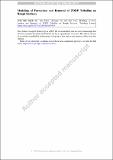Modeling of Formation and Removal of ZDDP Tribofilm on Rough Surfaces
Author(s)
Chen, Zhe; Gu, Chongjie; Tian, Tian
Download11249_2020_1393_ReferencePDF.pdf (1.055Mb)
Publisher Policy
Publisher Policy
Article is made available in accordance with the publisher's policy and may be subject to US copyright law. Please refer to the publisher's site for terms of use.
Terms of use
Metadata
Show full item recordAbstract
Abstract
Zinc dialkyldithiophosphate (ZDDP) is a widely used lubricant additive due to its high effectiveness in reducing wear by forming a tribofilm on sliding surfaces. However, the formation and removal of tribofilm are two competing processes depending on the working conditions, and ZDDP loses its anti-wear function when the removal process prevails. In this paper, a numerical model is built up to predict if ZDDP tribofilm can cover the sliding surfaces and protect them from wear. The input of this model includes the morphology of two sliding surfaces and parameters related to the surface materials, the working conditions and the lubricant, and the output is the surface with tribofilm and/or wear. Then, this model is used for the cylinder liner surface of an internal combustion engine, and a modeling result matching the actual case is obtained, proving that this model can be used in the design of an efficient lubrication system by searching the optimum combination of various parameters. Additionally, it is found that the resolution of the input surfaces has an impact on the modeling result, indicating that caution should be taken when comparing surfaces with different resolutions.
Graphical Abstract
Date issued
2021-01-12Department
Massachusetts Institute of Technology. Department of Mechanical EngineeringPublisher
Springer US
Citation
Tribology Letters. 2021 Jan 12;69(1):13
Version: Author's final manuscript